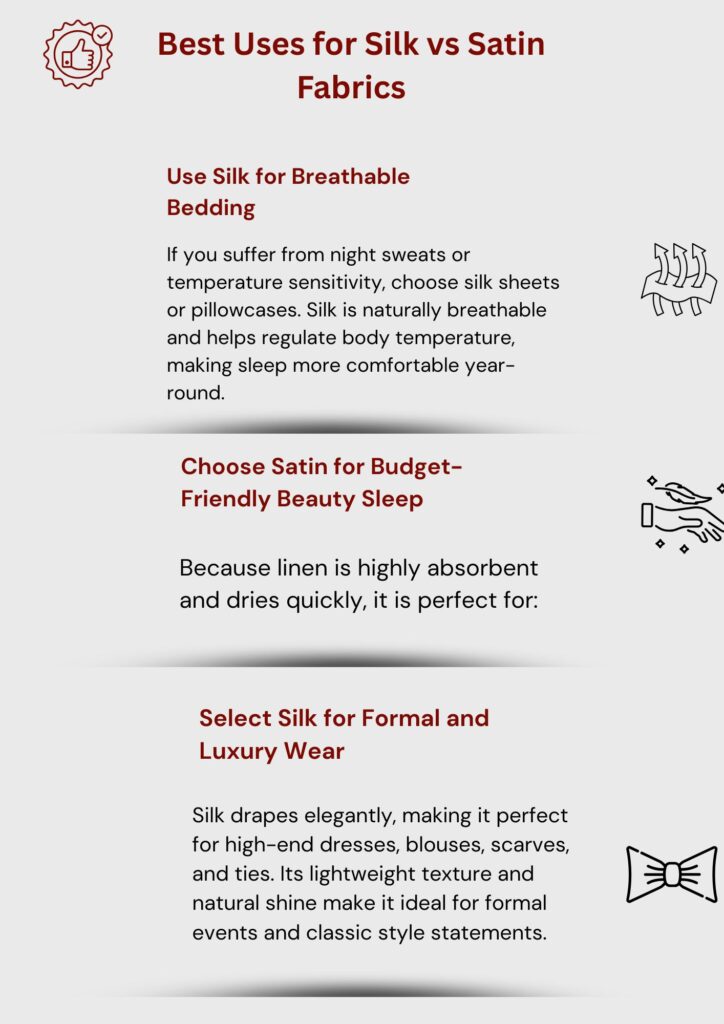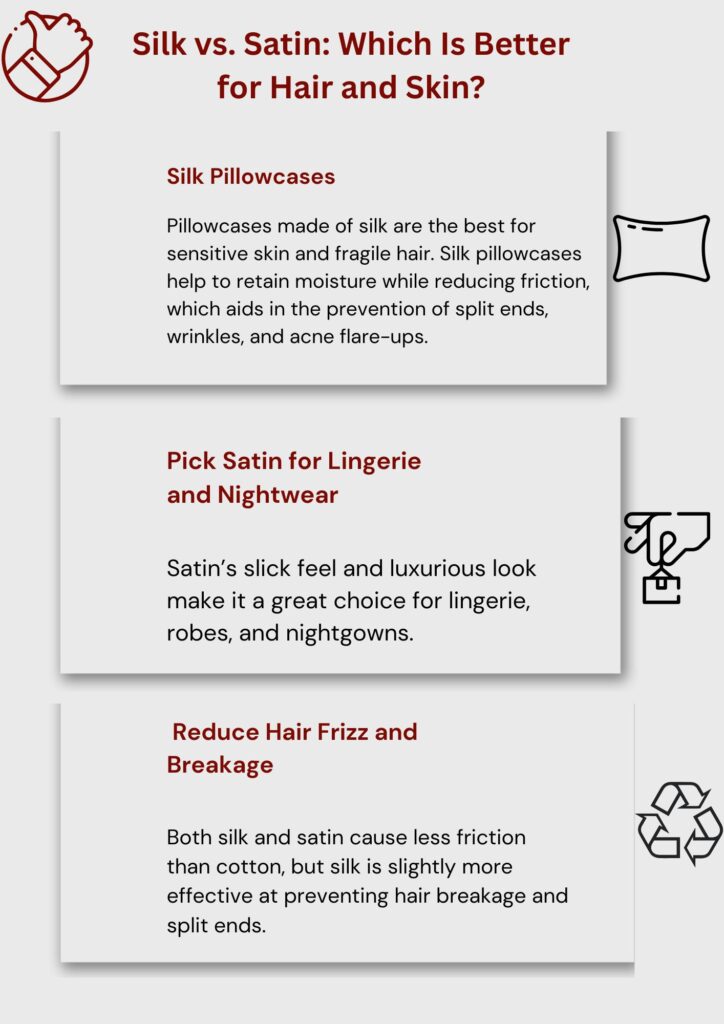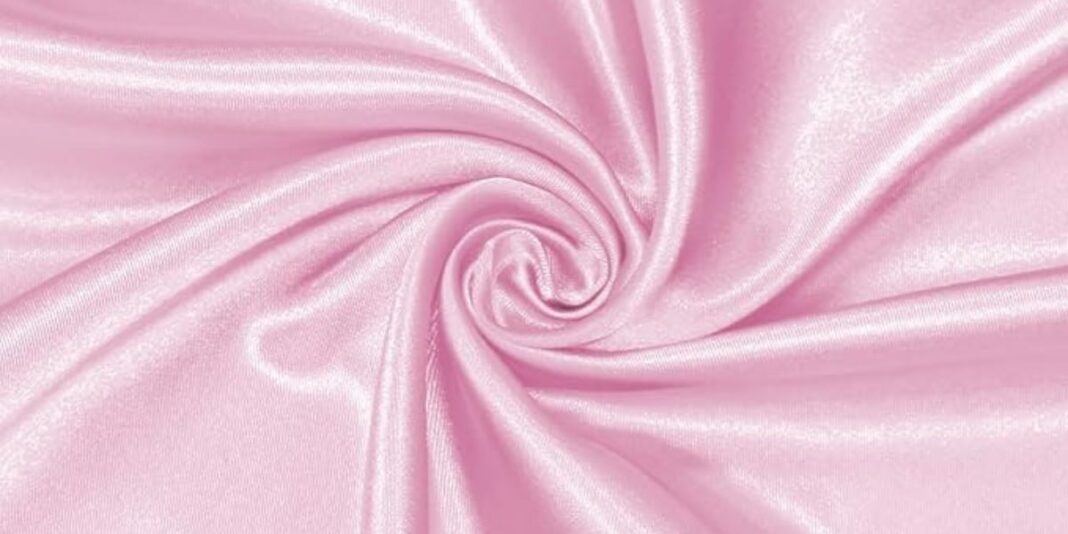Introduction
Both satin and silk exude signs of class and elegance. Their tempting and glossy surfaces often lead people to think they are the same fabric. In however, the difference between silk and satin is not only how they look or feel.
Most shoppers confuse these two fabrics, not knowing that one is a natural fiber and the other is a weave. The focus of this article is to explain the matter is further proceedings to help you grasp the concept. We will outline their history, characteristics, common applications, and how they can be differentiated.
Understanding these fabrics make one wise, be it in terms of apparel, bedding, or even beauty accessories.
What is Silk? One of the Inventions of Nature is Created by Silkworms
Definition and Natural Origin
Silk is a natural protein fiber made by silkworms, specifically Bombyx mori. These small creatures spin silk cocoons which can be harvested to make luxurious silk textiles. This fiber like many others, has been utilized for centuries, especially in ancient China where silk production began.
The complete process of making silk is quite demanding and this is why is so expensive. Silk also has the benefit of being natural and biodegradable. Along with this, silk is a skin friendly fabric.
Forms of Silk
Silk is classified into various types based on their unique textures and properties:
Mulberry Silk: The highest quality silk and most widely used.
- Tussar Silk: A more textured wild silk with a natural golden hue.
- Charmeuse Silk: Lightweight silk with glossy front and a dull back.
- Eri and Muga Silk: Of lower importance, silks used primarily in Indian traditional textiles.
Every type adds a unique distinction in texture and appearance that silk can be used for numerous luxury items.
Key Characteristics of Silk
The love for silk stems from its natural breathability, softness, and luster. It helps balance and control body temperature keeping one cool in summer and warm in winter. Its texture is soft, fluid, and effortlessly glides on the skin.
Silk is hypoallergenic and resistant to dust mites, mold, and other allergens. Silk combines durability, requiring gentleness on the fabric, with tender care in preserving its charm.
What Is It: Shiny Fabric That is Woven: Satin
Classification of Satin
Satin is not classified as fiber. Rather, it is weaving technique, just like satin is not fiber, a piece of cloth can be made using a satin weave. While the satin weave does provide some texture to the material, it also adds smooth and glossy satin cotton on one side. This shiny effect is a result of warp strings of yarn being led over the weft and interlacings being minimized.
Since the way satin is woven determines its characteristics, it can be crafted from various fibers, whether natural or synthetic.
Composition of Satin
Fibers that can compose satin include:
- Silk, natural
- Polyester, synthetic
- Nylon
- Rayon
Although satin produced from polyester or nylon is less expensive than silk satin, it comes not being breathworthy and luxurious.
Essential Features of Satin
The most common types of satin all share a shiny, smooth and slippery surface. Because it drapes beautifully, satin is favored as evening wear, lingerie, and stylish bedding. Like all synthetics, opposed to silk, satin is made using synthetic fibers making it non breathable.
Satin pillowcases have become popular because of the smooth texture benefiting hair and skin, along with mask and shower caps aiding smooth surfaces prevents fuzzing.
Silk and Satin Comparison
Differences in Origin: Silk vs satian
The distinction between satin and silk stems from their origins. Silk, the natural fiber from silkworms, contrasts with satin, a weave style applied to various fibers. Thus, satin’s origin can be both natural and synthetic.
Silk is always silk, but satin can be woven from other materials like polyester. This adds a positive consideration of greater price and appearance versatility to satin, although not always in terms of quality.
Breathability
The trademarks of silk includes a gentle sheen, which coupled with softness, renders a warmer feel than a poly blend satin. Depending on its weave, silk can look matte or glossier. In comparison, satin does have a high gloss smooth finish. It is, however, less expensive than silk. The shine from satin is usually high gloss and more artificial than silk, which appears matte.
Permitting for ease of movement and comfort, silk, satin, especially when stitched from synthetic materials, hinders airflow which results in sweating. Therefore, silk reigns supreme in this breathability comparison.
Durability & Care
Because silk is delicate, it is prone to damages from heat, sunlight, and detergents. Synthetic versions of Satin are easier to care for as they are more durable. However, because of the loose weave used in its construction, satin is susceptible to snagging.
Price: Luxury vs Affordability
Silk is regarded as a luxurious fabric, making it expensive. Conversely, satin made from polyester immitates silks appearance at a significantly lower cost.
Common Myths Regarding Silk and Satin
Many individuals make the mistake of thinking that there is no difference between silk and satin:
- “All satin is silk ”– This statement is incorrect. Apart from silk, satin can be made from polyester, nylon, or rayon.
- “Silk is always shiny” – Not always. Some weaves like crepe or raw silk are matte in appearance.
- “Satin is a natural fabric” – Incorrect. Satin is a weave, not a type of fiber.
Understanding these misconceptions enable one to make more informed shopping decisions.
Best Uses for Silk vs Satin Fabrics

Uses of Silk:
Silk is perfect for;
- High end dresses, blouses and ties
- High end temperature regulating bedding and sleep wrinkle resisting pillow cases
- Hair and skin gentle scarves and accessories.
Upper echelon and functional apparel silk does wonders for breathability and elegance.
Best Applications of Satin
Satin does particularly well in:
- Bridal gowns and evening garments where movement and luster are pivotal.
- As lingerie and nightwear due to its smooth and skin-friendly character.
- Cost-effective pillowcases that provide some beauty care to hair and skin.
Satin is best when the desire is for glamour yet at an affordable price.
Silk Versus Satin: Benefits and Issues
Silk Advantages and Disadvantages
Advantages:
- Naturally occurring and non-irritating
- Exceptional at maintaining comfortable temperatures
- Gentle, refined, and decadent
Disadvantages:
- High priced
- Requires special handling
- Prone to yellowing or staining
- Satin Advantages and Disadvantages
Advantages:
- Cost effective and easily available
- Very shiny and smooth
- Does not wrinkle as easily (plastic)
Disadvantages:
- Not as breathable as silk
- May feel too slick or synthetic
- Plastic versions may retain warmth
Silk vs. Satin: Methods of Differentiation
Burn Test
Conducting a burn test with a small thread can provide distinguishing features for both types:
- Silk burns and smells like hair, turning to ash.
- Satin burns differently, especially the synthetic varieties. It will smell like burning plastic and will melt.
Touch Test
The differences between satin and silk fabrics can be distinguished through touch also. Silk is warmer and more organic, and while it’s smooth, it isn’t slippery. Satin is cool to the touch and slicker, particularly when derived from polyester.
Label Check
Labels are often disregarded, but they contain valuable information. Look for
- “100% silk” for genuine silk.
- “Satin weave” or “polyester satin” for satin.
Don’t assume gloss means silk—labels are your best guide.
Silk vs. Satin: Which Is Better for Hair and Skin?

Silk Pillowcases
Pillowcases made of silk are the best for sensitive skin and fragile hair. Silk pillowcases help to retain moisture while reducing friction, which aids in the prevention of split ends, wrinkles, and acne flare-ups.
Satin Pillowcases
These offer a cheaper alternative to silk pillowcases. While offering some smoothing features and reduced friction, they are not as breathable. If made from polyester, these can hold heat thus leading to sweating.
Sustainability & Ethical Considerations
Environmental Impact of Silk
Unlike many other fabrics, silk is natural and biodegradable. However, the traditional method of silk production poses issues of boiling silkworms, which is ethically concerning, particularly for vegans. On the other hand, peace silk allows moths to hatch, which provides a cruelty-free alternative.
Sustainability of Satin
As with most fabric types, synthetic satin (such as polyester) is non-biodegradable satin and a product of poly-ethylene and petroleum compounds. Silk satin is an expensive alternative but makes a better environmental choice. Remember to consider the fiber content during sustainable shopping.
FAQs
It depends. Satin is good for budget needs, but silk offers better breathability and luxury.
Yes. Silk satin is the best of both worlds—luxury fiber with a satin weave.
Silk is labor-intensive to produce and comes from natural sources. Synthetic satin is machine-made.
Silk is better due to its breathability and moisture retention. Satin helps too, but not as much.


